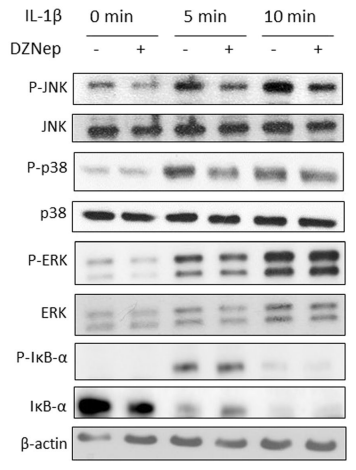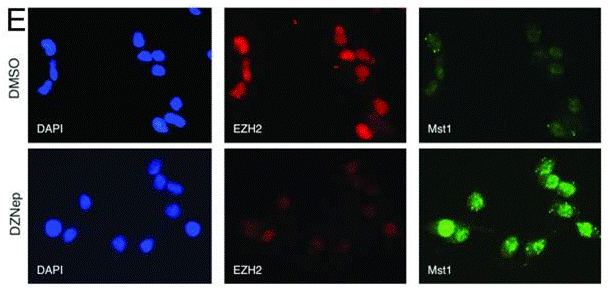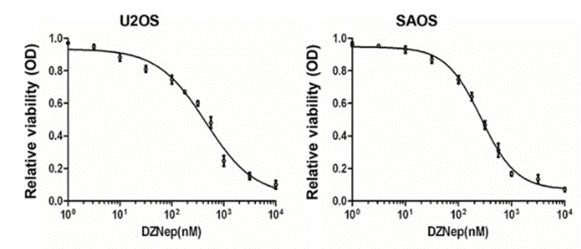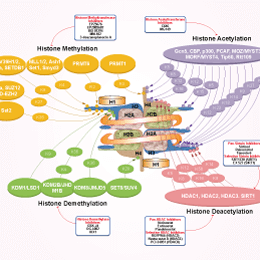
- Bioactive Compounds
- By Signaling Pathways
- PI3K/Akt/mTOR
- Epigenetics
- Methylation
- Immunology & Inflammation
- Protein Tyrosine Kinase
- Angiogenesis
- Apoptosis
- Autophagy
- ER stress & UPR
- JAK/STAT
- MAPK
- Cytoskeletal Signaling
- Cell Cycle
- TGF-beta/Smad
- DNA Damage/DNA Repair
- Compound Libraries
- Popular Compound Libraries
- Customize Library
- Clinical and FDA-approved Related
- Bioactive Compound Libraries
- Inhibitor Related
- Natural Product Related
- Metabolism Related
- Cell Death Related
- By Signaling Pathway
- By Disease
- Anti-infection and Antiviral Related
- Neuronal and Immunology Related
- Fragment and Covalent Related
- FDA-approved Drug Library
- FDA-approved & Passed Phase I Drug Library
- Preclinical/Clinical Compound Library
- Bioactive Compound Library-I
- Bioactive Compound Library-Ⅱ
- Kinase Inhibitor Library
- Express-Pick Library
- Natural Product Library
- Human Endogenous Metabolite Compound Library
- Alkaloid Compound LibraryNew
- Angiogenesis Related compound Library
- Anti-Aging Compound Library
- Anti-alzheimer Disease Compound Library
- Antibiotics compound Library
- Anti-cancer Compound Library
- Anti-cancer Compound Library-Ⅱ
- Anti-cancer Metabolism Compound Library
- Anti-Cardiovascular Disease Compound Library
- Anti-diabetic Compound Library
- Anti-infection Compound Library
- Antioxidant Compound Library
- Anti-parasitic Compound Library
- Antiviral Compound Library
- Apoptosis Compound Library
- Autophagy Compound Library
- Calcium Channel Blocker LibraryNew
- Cambridge Cancer Compound Library
- Carbohydrate Metabolism Compound LibraryNew
- Cell Cycle compound library
- CNS-Penetrant Compound Library
- Covalent Inhibitor Library
- Cytokine Inhibitor LibraryNew
- Cytoskeletal Signaling Pathway Compound Library
- DNA Damage/DNA Repair compound Library
- Drug-like Compound Library
- Endoplasmic Reticulum Stress Compound Library
- Epigenetics Compound Library
- Exosome Secretion Related Compound LibraryNew
- FDA-approved Anticancer Drug LibraryNew
- Ferroptosis Compound Library
- Flavonoid Compound Library
- Fragment Library
- Glutamine Metabolism Compound Library
- Glycolysis Compound Library
- GPCR Compound Library
- Gut Microbial Metabolite Library
- HIF-1 Signaling Pathway Compound Library
- Highly Selective Inhibitor Library
- Histone modification compound library
- HTS Library for Drug Discovery
- Human Hormone Related Compound LibraryNew
- Human Transcription Factor Compound LibraryNew
- Immunology/Inflammation Compound Library
- Inhibitor Library
- Ion Channel Ligand Library
- JAK/STAT compound library
- Lipid Metabolism Compound LibraryNew
- Macrocyclic Compound Library
- MAPK Inhibitor Library
- Medicine Food Homology Compound Library
- Metabolism Compound Library
- Methylation Compound Library
- Mouse Metabolite Compound LibraryNew
- Natural Organic Compound Library
- Neuronal Signaling Compound Library
- NF-κB Signaling Compound Library
- Nucleoside Analogue Library
- Obesity Compound Library
- Oxidative Stress Compound LibraryNew
- Plant Extract Library
- Phenotypic Screening Library
- PI3K/Akt Inhibitor Library
- Protease Inhibitor Library
- Protein-protein Interaction Inhibitor Library
- Pyroptosis Compound Library
- Small Molecule Immuno-Oncology Compound Library
- Mitochondria-Targeted Compound LibraryNew
- Stem Cell Differentiation Compound LibraryNew
- Stem Cell Signaling Compound Library
- Natural Phenol Compound LibraryNew
- Natural Terpenoid Compound LibraryNew
- TGF-beta/Smad compound library
- Traditional Chinese Medicine Library
- Tyrosine Kinase Inhibitor Library
- Ubiquitination Compound Library
-
Cherry Picking
You can personalize your library with chemicals from within Selleck's inventory. Build the right library for your research endeavors by choosing from compounds in all of our available libraries.
Please contact us at info@selleckchem.com to customize your library.
You could select:
- Antibodies
- Bioreagents
- qPCR
- 2x SYBR Green qPCR Master Mix
- 2x SYBR Green qPCR Master Mix(Low ROX)
- 2x SYBR Green qPCR Master Mix(High ROX)
- Protein Assay
- Protein A/G Magnetic Beads for IP
- Anti-Flag magnetic beads
- Anti-Flag Affinity Gel
- Anti-Myc magnetic beads
- Anti-HA magnetic beads
- Poly DYKDDDDK Tag Peptide lyophilized powder
- Protease Inhibitor Cocktail
- Protease Inhibitor Cocktail (EDTA-Free, 100X in DMSO)
- Phosphatase Inhibitor Cocktail (2 Tubes, 100X)
- Cell Biology
- Cell Counting Kit-8 (CCK-8)
- Animal Experiment
- Mouse Direct PCR Kit (For Genotyping)
- New Products
- Contact Us
research use only
3-Deazaneplanocin A (DZNep) Hydrochloride Histone Methyltransferase inhibitor
DZNeP (3-deazaneplanocin A) HCl, an analog of adenosine, is a competitive inhibitor of S-adenosylhomocysteine hydrolase with Ki of 50 pM in a cell-free assay.
-chemical-structure-s7120.gif)
Chemical Structure
Molecular Weight: 298.73
Purity & Quality Control
Batch:
Purity:
99.92%
99.92
Related Products
| Related Targets | Menin-MLL interaction WDR5-MLL interaction | Click to Expand |
|---|---|---|
| Related Products | GSK126 GSK343 Pinometostat (EPZ5676) BIX-01294 trihydrochloride EPZ004777 EPZ015666 (GSK3235025) UNC1999 Chaetocin EPZ005687 Pemrametostat (GSK3326595) SGC 0946 MM-102 UNC0638 EPZ011989 UNC0642 OICR-9429 UNC0379 GSK591 Lirametostat (CPI-1205) MI-2 (Menin-MLL Inhibitor) | Click to Expand |
| Related Compound Libraries | Kinase Inhibitor Library FDA-approved Drug Library Natural Product Library Bioactive Compound Library-I Highly Selective Inhibitor Library | Click to Expand |
Signaling Pathway
Cell Culture and Working Concentration
| Cell Lines | Assay Type | Concentration | Incubation Time | Formulation | Activity Description | PMID |
|---|---|---|---|---|---|---|
| human PC3 cells | Cytotoxic assay | 72 h | Cytotoxicity against human PC3 cells assessed as inhibition of cell proliferation after 72 hrs by sulforhodamine B assay, IC50=9.39 μM. | 26010585 | ||
| human A549 cells | Cytotoxic assay | 72 h | Cytotoxicity against human A549 cells assessed as inhibition of cell proliferation after 72 hrs by sulforhodamine B assay, IC50=1.4 μM. | 26010585 | ||
| human SNU638 cells | Cytotoxic assay | 72 h | Cytotoxicity against human SNU638 cells assessed as inhibition of cell proliferation after 72 hrs by sulforhodamine B assay, IC50=0.91 μM. | 26010585 | ||
| human SKHEP1 cells | Cytotoxic assay | 72 h | Cytotoxicity against human SKHEP1 cells assessed as inhibition of cell proliferation after 72 hrs by sulforhodamine B assay, IC50=0.72 μM. | 26010585 | ||
| human MDA-MB-231 cells | Cytotoxic assay | 72 h | Cytotoxicity against human MDA-MB-231 cells assessed as inhibition of cell proliferation after 72 hrs by sulforhodamine B assay, IC50=0.3 μM. | 26010585 | ||
| human HCT116 cells | Cytotoxic assay | 72 h | Cytotoxicity against human HCT116 cells assessed as inhibition of cell proliferation after 72 hrs by sulforhodamine B assay, IC50=0.26 μM. | 26010585 | ||
| Click to View More Cell Line Experimental Data | ||||||
Mechanism of Action
| Features | Carbocyclic analog of adenosine, and acts as anti-tumor and anti-virus inhibitor of EZH2. | ||
|---|---|---|---|
| Targets |
|
In vitro |
||||
| In vitro | 3-Deazaneplanocin A (1.0 μM) results in a significant increase in accumulation of cells in the G0/G1 phase (58.5%) with a concomitant decrease in the number of cells in S phase (35.2%) and G2/M phases (6.3%) of the cell cycle of human acute myeloid leukemia OCI-AML3 cells. 3-Deazaneplanocin A (1.0 μM) induces apoptosis in OCI-AML3 (~50%) and HL-60 cells (~50%), and a more than 90% reduction in colony growth at 48 hr. 3-Deazaneplanocin A depletes EZH2 levels, and inhibits trimethylation of lysine 27 on histone H3 in the HL-60 and OCI-AML3 cells and in primary AML cells. 3-Deazaneplanocin A treatment induces p16, p21, p27, and FBXO32 while depleting cyclin E and HOXA9 levels. 500 nM 3-Deazaneplanocin A induces differentiation of HL-60 to CD11b+ cell by nearly 3-folds time at 48 h. [2] 3-Deazaneplanocin A has excellent activity against several viral types. 3-Deazaneplanocin A is activity against vesicular stomatitis in L929 cells, parainfluenza 3 in H.Ep-2, vaccinia and yellow fever viruses in vero cells with IC50 of 0.2, 3.6, 2.1 and 2.9 μg/mL, respectively. [3] 3-Deazaneplanocin A displays a strongly and uniformly leishmanistatic effect on American Leishmania (L mexicana and L brasiliensis) strains in the study with average ID50 of 96 ng/mL, but shows no inhibition against the several T. cruzi and T. rangeli strains tested with concentrations up to 10 μg/mL. At a dose of 200 ng/mL, 3-Deazaneplanocin A inhibits S-adenosyl-L-3H-methylmethionine and 3-thymidine incorporation by promastigotes after four days. At a dose of 100 ng/mL, 3-Deazaneplanocin A eliminates approximately 56% of the L mexicana and L brasiliensis from infected human macrophages. [4] |
|||
|---|---|---|---|---|
| Kinase Assay | S-adenosylhomocysteine hydrolase activity assay | |||
| The reaction mixture used for assay of AdoHcyase contains, in a final volume of 0.5 mL, 50 mM potassium phosphate (pH 7.6), 5 mM dithiothreitol, 1 mM EDTA, 10% glycerol, and the enzyme. L-[8- 14C]AdoHcy is used as substrate and 5 units of calf intestinal adenosine deaminase are included. The reaction is stopped by the addition of 100 μL of 5 M formic acid, and the reaction mixture is then poured onto a column (0.8×2.5 cm) of SP-Sephadex C-25, previously equilibrated in 0.1 M formic acid. Each test tube is rinsed with 0.5 mL of 0.1 M formic acid. [14C]Inosine formed is eluted from the column by 3.5 mL of 0.1 M formic acid into a scintillation vial. The radioactivity is determined after the addition of 10 mL of scintillation fluid. The amount of enzyme used is about 105 pU, or 75 ng of the purified enzyme. One unit is the amount of enzyme needed to form 1 pmol of product in 1 min at 37 ℃. | ||||
| Cell Research | Cell lines | Human acute myeloid leukemia HL-60 | ||
| Concentrations | ~1 μM | |||
| Incubation Time | 2 days | |||
| Method | Cells are treated with the indicated concentrations of 3-Deazaneplanocin A for 48 hours. After the designated treatments, cells are harvested and washed twice with PBS, and approximately 500 cells are plated in complete Methocult and cultured for 7 to 10 days at 37 ℃ in a 5% CO2 environment. Cells are dyed with crystal violet, and relative colony density is determined by solubilizing the crystal violet dye in 10% acetic acid followed by measurement of absorbance at 450 nm. |
|||
| Experimental Result Images | Methods | Biomarkers | Images | PMID |
| Western blot | p-JNK / JNK / p-p38 / p38 / p-ERK / ERK / p-IκB-α / IκB-α HOXA6 / HOXB3 / HOXC4 / HOXD13 EED / p21 / p-RB / p27 / p-CDC2 TGFBR1 / TGFBR2 / Smad3 Suz12 / H3K4me3 / H3K36me2 EZH2 / H3K27me3 |

|
28744016 | |
| Immunofluorescence | EZH2 / Mst1 F-actin / Paxillin α-tubulin |

|
24499724 | |
| Growth inhibition assay | Cell viability |

|
27223261 | |
In Vivo |
||
| In vivo | 3-Deazaneplanocin A shows antileukemia activity in vivo. 3-Deazaneplanocin A at the doses of 8 mg/kg shows in vivo antiviral activity against vaccinia virus in a mouse tailpox assay with median of 0.0 poxftail (84% protection). [3] 3-Deazaneplanocin A at the doses ranging from 0.5 to 1.5 mg/kg/day, significantly reduced development of cutaneous leishmanial infection produced in inbred BALB/c mice by L. b. guyanensis inoculation. [4] 3-Deazaneplanocin A induces massively increased interferon-α production in Ebola virus-infected mice. 3-Deazaneplanocin A (s.c. injection of 2 mg/kg postinfection) prevents death in mice infected with 1000 pfu (30 000 LD50) of mouse-adapted EBO-Z. Treatment with 3-Deazaneplanocin A on day 1 reduces mean serum viral titers on day 2 by 100-fold and on day 3 by 100 000-fold, compared with placebo controls, and results in a mean serum IFN-α level of 1420 pg/mL on day 2 and 1830 pg/mL on day 3. [5] |
|
|---|---|---|
| Animal Research | Animal Models | Human acute myeloid leukemia xenografts HL-60 |
| Dosages | 1 mg/kg | |
| Administration | initiated on day 7 and administered twice per week (Tuesday-Thursday) intraperitoneally for 2 weeks | |
References |
|
Chemical Information
| Molecular Weight | 298.73 | Formula | C12H14N4O3.HCl |
| CAS No. | 120964-45-6 | SDF | Download SDF |
| Synonyms | NSC 617989 HCl | ||
| Smiles | C1=CN=C(C2=C1N(C=N2)C3C=C(C(C3O)O)CO)N.Cl | ||
Storage and Stability
| Storage (From the date of receipt) | |||
|
In vitro |
DMSO : 60 mg/mL ( (200.85 mM) Moisture-absorbing DMSO reduces solubility. Please use fresh DMSO.) Water : 60 mg/mL Ethanol : Insoluble |
Molecular Weight Calculator |
|
In vivo Add solvents to the product individually and in order. |
In vivo Formulation Calculator |
|||||
Preparing Stock Solutions
Molarity Calculator
In vivo Formulation Calculator (Clear solution)
Step 1: Enter information below (Recommended: An additional animal making an allowance for loss during the experiment)
mg/kg
g
μL
Step 2: Enter the in vivo formulation (This is only the calculator, not formulation. Please contact us first if there is no in vivo formulation at the solubility Section.)
% DMSO
%
% Tween 80
% ddH2O
%DMSO
%
Calculation results:
Working concentration: mg/ml;
Method for preparing DMSO master liquid: mg drug pre-dissolved in μL DMSO ( Master liquid concentration mg/mL, Please contact us first if the concentration exceeds the DMSO solubility of the batch of drug. )
Method for preparing in vivo formulation: Take μL DMSO master liquid, next addμL PEG300, mix and clarify, next addμL Tween 80, mix and clarify, next add μL ddH2O, mix and clarify.
Method for preparing in vivo formulation: Take μL DMSO master liquid, next add μL Corn oil, mix and clarify.
Note: 1. Please make sure the liquid is clear before adding the next solvent.
2. Be sure to add the solvent(s) in order. You must ensure that the solution obtained, in the previous addition, is a clear solution before proceeding to add the next solvent. Physical methods such
as vortex, ultrasound or hot water bath can be used to aid dissolving.
Tech Support
Answers to questions you may have can be found in the inhibitor handling instructions. Topics include how to prepare stock solutions, how to store inhibitors, and issues that need special attention for cell-based assays and animal experiments.
Tel: +1-832-582-8158 Ext:3
If you have any other enquiries, please leave a message.
* Indicates a Required Field






































